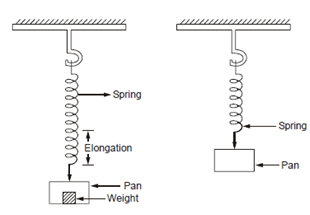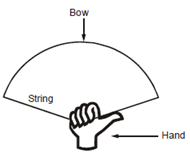Elasticity:
Whenever an external force is applied on a body, it is deformed (that is, its shape or size or both changes). The extent of deformation depends upon the nature of the material and shape of the body and the manner in which the force is applied. As soon as the external (deforming) force is removed, the body regains its original state. This characteristic of the body to regain its original shape and size is called elasticity.
We come across many situations in our daily life in which the elasticity of solids is evident. For example, when a force is applied at one end of a metallic spring fixed at the other end, it elongates (Figure(a)). When the force is removed by removing weights on the pan, it comes to its original position (Figure(b)). Other examples of elasticity are: a rubber ball gets deformed when we apply a force on it; mattresses compress when we sleep; application of a force on the string of a bow produced deformation in the bow (Figure). All these objects regain their original condition (shape and size) as soon as the applied force is removed.

(a) (b)
Figure: (a) Elongated Spring due to Weight on the Pan; and (b) The Spring Returns Back to its Normal Length when Weight is Removed

Figure: Stretching the Spring Produces Deformation in the Bow
At this stage, you may ask: Is it always true that a body regains its original shape and size once the deforming force is removed? To answer this question, we need to understand the concepts of elastic limit and the difference between elastic and plastic bodies.